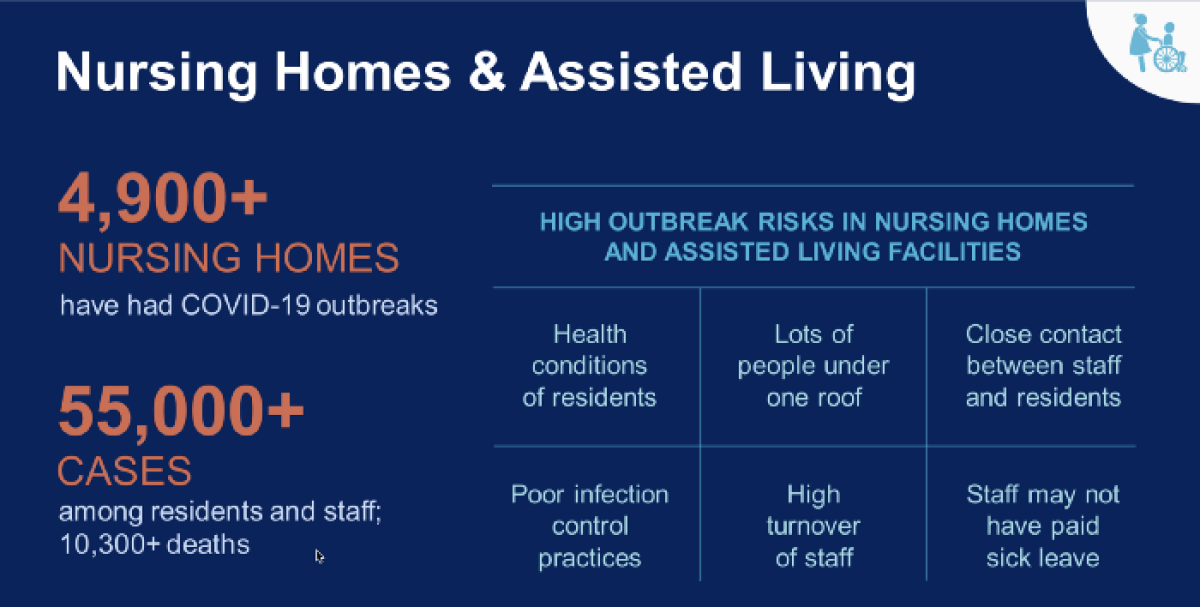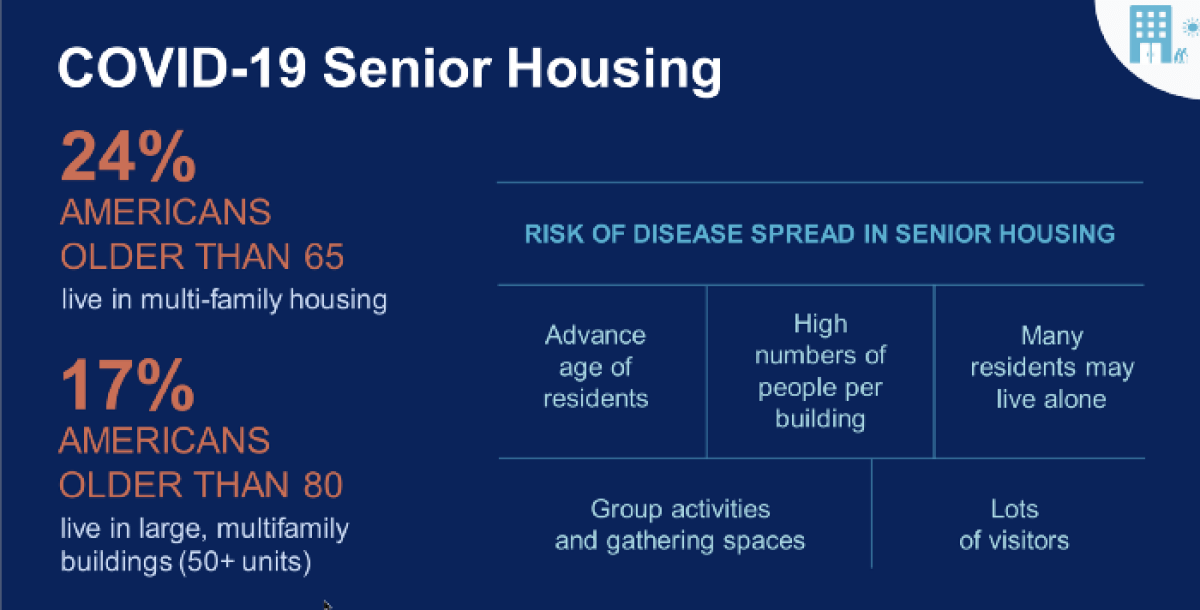Prioritize nursing homes and senior housing now, health expert warns

If there’s a Ground Zero in the Covid-19 crisis, it’s nursing homes and assisted living facilities. Across the United States, nearly 5,000 of these locations have had virus outbreaks, accounting for more than 10,000 deaths. The elderly residents of these homes and the staff who care for them now account for about one in five of all people who have died from the disease.
Mayors aren’t ideally positioned to fix this problem, as nursing homes generally fall under federal and state government oversight. But there are things they can and should do to make a difference in their cities.
Outlining those steps was a primary focus on yesterday’s online coaching and learning session of the Covid-19 Local Response Initiative. Dr. Jennifer Nuzzo of the Johns Hopkins Bloomberg School of Public Health Center for Health Security told mayors there’s good reason for them to protect seniors in these high-risk settings.
“It’s really important that we find ways to do this,” Nuzzo said, “because preventing illness in our most vulnerable community is how we are going to save lives and ease the burden on our health systems now — and in particular, after we begin to ease up some of the social distancing.”
Nuzzo said there are four ways mayors can act now to save lives in their local nursing homes and assisted living facilities:
● Establish a response team to help support these facilities. While the federal Centers for Disease Control and Prevention and state health departments publish guidelines that facilities are supposed to adhere to, compliance and enforcement can be spotty. Nuzzo said mayors can set up local response teams to work with facilities to make sure they’re adhering to guidelines to prevent Covid-19 from spreading and to identify solutions when difficulties arise. “The idea is not to be punitive,” she said, but rather “to engage with these facilities in a collaborative fashion. These are enormous challenges and they simply can’t do it alone.”
● Maintain two-way communication. Mayors or their staff should regularly check in with nursing homes to discuss new guidelines as they come up and help problem-solve issues along the way. This is where having a response team ready to troubleshoot problems quickly can save valuable time.
● Help maintain adequate staffing levels. As cities are seeing with their first responders, the staff working in nursing homes are vulnerable to infection or virus exposures forcing them to quarantine. That’s left many homes short-staffed, which can exacerbate safety problems. Mayors can help, Nuzzo said, by mobilizing healthcare volunteers, doctors, nurses, med-techs, and other clinicians available to help out in a facility that might be dangerously understaffed.
● Prioritize nursing homes for testing and medical supplies. As shortages of Covid-19 tests ease, the residents and staff at nursing homes should be at the top of the list of who gets them. Testing everybody at the first sign of an outbreak can identify infections before they spread and contain the damage. “Ensuring that these facilities have priority access to medical supplies and testing is really important,” Nuzzo said. “You can use your position to advocate for the facilities that are in your communities, particularly as additional resources may be coming into your state.”
In addition to nursing homes and assisted living facilities, Nuzzo said mayors need to look out for people living in senior housing communities. One in four Americans older than 65 lives in a multi-family housing environment, opening them to risks of virus exposure from visitors who come and go. And a majority of them live alone.
Nuzzo said there are three steps mayors can take specifically to address the needs of residents in these communities.
● Target your communications. Since residents in senior communities are generally healthier and more independent than nursing home residents, they may not see themselves in much danger. However, risk for severe outcomes with Covid-19 jumps dramatically for people over age 65. Mayors can target communications specifically to older adults living in senior communities about the need to stay home, for example. “Broadcasting general messages about age-related risks is not enough,” Nuzzo said. “If we want to protect at-risk elderly, we need to make sure they hear those messages and see themselves in those messages, and make sure the messages are specific and actionable enough that they know what they’re supposed to do.”
● Boost support services for seniors. Orders to stay home can be especially hard for older people living alone. They may struggle to get food or medications, or need help taking care of a pet. Local governments don’t have the resources — especially now — to solve all of this problem, but mayors can convene partners from the private and nonprofit sectors to build networks to support seniors through this time.
● Combat loneliness. When the time comes to gradually and safely re-open society, seniors will continue to be advised to stay at home. While that will keep older Americans better protected from Covid-19, it also means the psychological toll of social distancing will last longer for them. To combat social isolation, cities can boost volunteer efforts aimed at connecting seniors to volunteers and each other by phone and online. Nuzzo cited a social networking app launched by the city of Barcelona, Spain, as an example of how cities can keep seniors informed and in touch during this extended period of isolation. “Mayors can play an important role in helping seniors remain connected and engaged despite social distancing,” she said.
See the slides from Dr. Jennifer Nuzzo’s presentation here.




